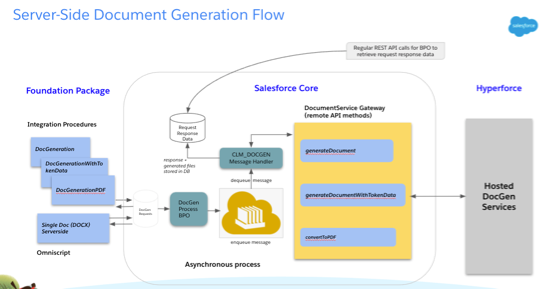Every company needs documents for its processes, information, contracts, proposals, quotes, reports, non-disclosure agreements, service agreements, and for various other purposes. Document creation and management is a crucial part of their operations. To make it easy, Omnistudio provides document generation capabilities, tailored to meet the unique requirements of different Industries. In this blog post, we will explore how OmniStudio empowers document generation across a range of industries, enhancing efficiency, accuracy, and compliance.
What is Industries Document Generation?
OmniStudio offers a powerful and robust solution for document generation across various industries, empowering organizations to automate and streamline their document creation processes.
To get the document generation capabilities, you need to install ‘OmniStudio’ and ‘Salesforce Industry’ packages in the same org. Within the package, you get the tools necessary to optimize the document generation process. A sample functionality comes with the package. You can leverage that or can build your own to fulfill your purposes. Let’s dive into how we can configure the document generation functionality.
How to generate documents?
The Industries Document Generation functionality uses Document Template along with Omnistudio components to generate documents. The Omnistudio components generally involve Omniscripts, Integration Procedures and Dataraptors. As part of the package, it provides two sample Omniscripts:
- Client-Side Omniscript: To generate documents with user inputs
- Server-Side Omniscript: To Generate documents without user interaction
You can leverage these Omniscripts or can create your own. The Dataraptors inside these Omniscripts extract require data from Salesforce and merge it with the document template to dynamically generate several documents from a single template file. The document template can be of type Microsoft Word (.docx), Microsoft PowerPoint (.pptx), and Web templates. The templates can be designed/configured inside the Document Template Designer.
Document Template Designer:
The Document Template Designer tool is one of the main components for the document generation functionality. It enables businesses to easily create and customize their document templates. It offers a user-friendly interface, allowing users to design visually appealing and professional templates tailored to their specific needs.
Below Image shows what it looks like.

Document Template Designer – Configuration
Here are some key features of Document Template Designer:
- Multiple Template Types:
The Document template designer allows us to create 3 types of templates:
-
- Vlocity Web Templates: Allows us to create template in the Template Designer itself.
- Microsoft Word .DOCX Template: Create a MS Word document and upload it in the Template Designer
- Microsoft Powerpoint .PPTX Template: Create a MS PPT document and upload it in the Template Designer
- Versioning and Template Management:
It allows users to manage multiple versions of their templates and track changes over time. For Word/PPT documents, you can simply replace the old file with an updated file.
- Dynamic Data Binding:
It enables users to insert Salesforce data into Tokens. Tokens are nothing but the Placeholder for the data fields in Salesforce. Learn more about the tokens in the Documentation – Tokens in Microsoft Word or Microsoft PowerPoint Documents
- Localization and Multi-Language Support:
Users can create templates in different languages, ensuring that documents can be generated to meet the diverse needs of their global customer base.
- Preview and Testing:
Prior to finalizing a document template, users can preview and test how the template will appear when populated with data.
Client-Side Document Generation:
The client-side document generation mechanism allows us to collect information from users and generate documents based on those inputs. Use client-side Omniscript that comes with the package or modify it depending on the requirements. This Omniscript enables the user to pick the document template and provides options for what type of document needs to be generated. Then, it passes this information as input parameters to an LWC component to generate the actual document. Then the generated document can be attached to a Salesforce object or can be stored in external systems.
Here are the features of Client-side Document Generation:
- Flexibility of document generation:
With Omniscript UI, user inputs can be taken to decide what type of document to generate. Users have flexibility to choose templates and a number of documents to generate.
- Runs on the client machine:
Client-side document generation is a browser-based process. This results in fast processing and saving round-trip to the server.
- Document Preview:
You can display a generated document to the user and can send the document via email or to other integrated systems.
Server-Side Document Generation:
Server-side document generation service defines the document generation process without having user interaction, i.e., all the processes for this technique happen in the back-end. It’s an asynchronous process built for generating large and heavy-rendering documents. It also uses either Apex classes, Integration Procedure, or sample Omniscript to generate documents.
The process for server-side document generation uses remote API services. These services hosted on Salesforce Hyperforce environment. Using Integration Procedures or apex code, it sends request to this environment to generate documents. The generated document then gets stored in Salesforce as content documents.
Here are the features of Server-side document Generation:
- Attachment and Storage Management:
The generated documents are stored in Salesforce Content. Additionally, upload them to external file storage systems or integrate with document management solutions for efficient storage and retrieval.
- Batch Processing:
It uses batch processing to go with Salesforce’s multi-tenant architecture, as it involves the processing of heavy documents.
- Automation:
The document generation process can be triggered based on specific events or actions, ensuring the right documents are generated at the right time.
- Scalability & Performance:
Server-side document generation in OmniStudio is designed to manage large volumes of data and generate documents efficiently. It ensures optimal performance and scalability, allowing businesses to generate documents at scale.
Conclusion:
Salesforce, with its industry-specific solutions and robust document generation capabilities, empowers businesses to automate and streamline their document generation and management processes. Providing personalized, compliant, and efficient document generation, helps organizations enhance customer experience, drive productivity, and achieve tangible business outcomes. Embracing the capabilities of Industries Document Generation can revolutionize your industry, enabling you to stay ahead in today’s competitive landscape.




Detailed Explanation, Thanks for sharing.
Can we use checkboxs on the word template and assign tokens , if yes could you please share some examples